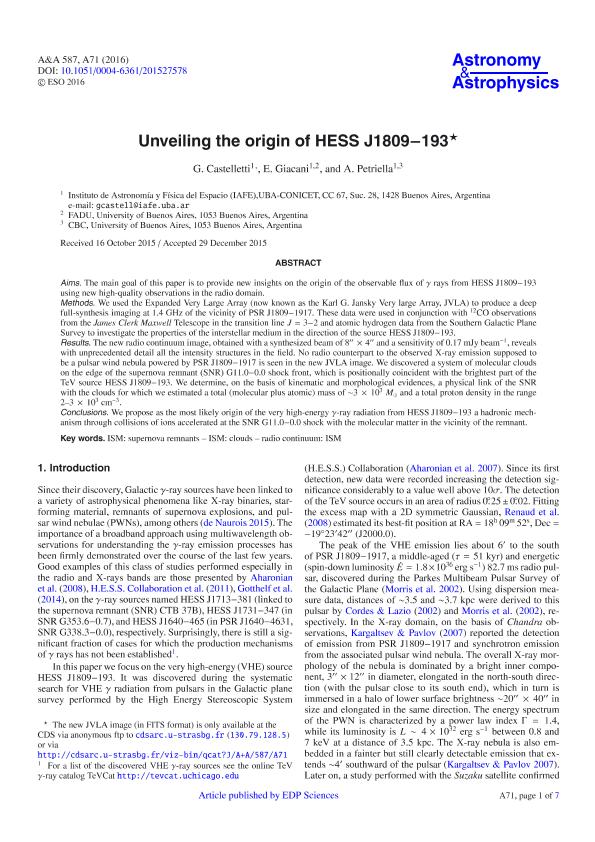Artículo
Unveiling the origin of HESS J1809-193
Fecha de publicación:
03/2016
Editorial:
EDP Sciences
Revista:
Astronomy and Astrophysics
ISSN:
0004-6361
Idioma:
Inglés
Tipo de recurso:
Artículo publicado
Clasificación temática:
Resumen
Aims: The main goal of this paper is to provide new insights on the origin of the observable flux of γ rays from HESS J1809-193 using new high-quality observations in the radio domain. Methods: We used the Expanded Very Large Array (now known as the Karl G. Jansky Very large Array, JVLA) to produce a deep full-synthesis imaging at 1.4 GHz of the vicinity of PSR J1809-1917. These data were used in conjunction with 12CO observations from the James Clerk Maxwell Telescope in the transition line J = 3-2 and atomic hydrogen data from the Southern Galactic Plane Survey to investigate the properties of the interstellar medium in the direction of the source HESS J1809-193. Results: The new radio continuum image, obtained with a synthesized beam of 8´´ × 4´´ and a sensitivity of 0.17 mJy beam-1, reveals with unprecedented detail all the intensity structures in the field. No radio counterpart to the observed X-ray emission supposed to be a pulsar wind nebula powered by PSR J1809-1917 is seen in the new JVLA image. We discovered a system of molecular clouds on the edge of the supernova remnant (SNR) G11.0-0.0 shock front, which is positionally coincident with the brightest part of the TeV source HESS J1809-193. We determine, on the basis of kinematic and morphological evidences, a physical link of the SNR with the clouds for which we estimated a total (molecular plus atomic) mass of ~3 × 103M⊙ and a total proton density in the range 2-3 × 103 cm-3. Conclusions: We propose as the most likely origin of the very high-energy γ-ray radiation from HESS J1809-193 a hadronic mechanism through collisions of ions accelerated at the SNR G11.0-0.0 shock with the molecular matter in the vicinity of the remnant.
Palabras clave:
Ism: Supernova Remnants
,
Ism: Clouds
,
Radio Continuum:Ism
Archivos asociados
Licencia
Identificadores
Colecciones
Articulos(IAFE)
Articulos de INST.DE ASTRONOMIA Y FISICA DEL ESPACIO(I)
Articulos de INST.DE ASTRONOMIA Y FISICA DEL ESPACIO(I)
Citación
Castelletti, Gabriela Marta; Giacani, Elsa Beatriz; Petriella, Alberto; Unveiling the origin of HESS J1809-193; EDP Sciences; Astronomy and Astrophysics; 587; A71; 3-2016; 1-7
Compartir
Altmétricas




